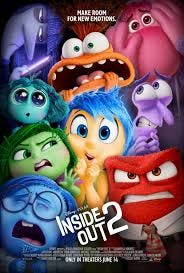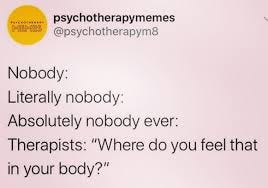“I don’t know how to stop Anxiety, maybe that’s what happens when you grow up — you feel less joy.”
Insights on Inside Out 2
Last week I discussed the Atlas of Emotions and the original 2015 Inside Out. This week I’m digging a bit deeper into emotion mapping and the introduction of anxiety in Inside Out 21.
.
It’s a meme-worthy joke that clinical social workers, like myself, will ask clients, “Where do you feel that emotion in your body?” It’s a meme is based in truth; there is an emerging field of somatic therapy and a growing body of research that focuses specifically on the mind-body connection for healing. One of the ideas within this field is that the intensity and locations one feels an emotion is important data for unraveling emotional mysteries. When I ask folks to examine where they feel these emotions, I’m considering the work done by Lauri Nummenmaa, Ph.D2., a Finnish researcher on Human Emotion Systems. I first stumbled onto his work in an article titled “Love Makes Us Warm All Over”3. Later in the article, they share, “A team of scientists in Finland asked people to map out where they felt different emotions on their bodies; they found that the results were surprisingly consistent, even across cultures.” This is fascinating to me! It points to how the nervous system is constantly taking in information to keep us prepared to be in fight or flight at any given time. See the graphic below for where Nummenmaa’s team found the five or seven ‘primary’ emotions mapped on bodies (red & yellows indicate warmth, blues cold, black is neutral). Is that true to where you feel these emotions?
This somatic understanding of the mind-body connection is the lens through which I saw Pixar’s Inside Out 2. Riley, the main character, is starting puberty and facing a whirlwind of social and emotional changes. Overnight, a new palette of emotions arrives: anxiety, ennui, embarrassment, and envy. These emotions show up and create havoc. Take a quick glance at Nummenmaa’s more complex emotions (below). Note how anxiety looks like fear and sadness being compounded, or how sadness is distinctively different from depression. What are your thoughts when you see shame or love? How about how contempt is warm in the upper body and cool in the hips? Beware of contempt, couples! (But that’s another post for another day.) These more complex emotions become more activated during puberty, confusing a body in transition, and it takes time for a developing brain to get a handle on how to manage these new perceptions.
These emotional sensations are a part of our wiring as humans and have served as important tools for the survival of our species. Yet, there are a lot of these emotions that we don’t want to feel. Anxiety seems to be a top unwanted or “bad” emotion in the rooms I hang out in. “I don’t know how to stop Anxiety. Maybe that’s what happens when you grow up — you feel less joy.” This line, spoken by Amy Poehler’s character Joy, seemed a little too close to home. When I heard it I may have let out a laugh that was a little too loud for a movie theater.
But, do we feel less joy as adults?4 Maybe, but maybe not. While I have more responsibility as a grown up, but as a survivor of junior high, I certainly wouldn’t ever want to do that again. Add your experience and thoughts in the comments below.
What’s interesting to me professionally is helping folks find tools to manage anxiety. This is what the movie shows Riley doing. She touches the bench next to her, sits still, and focuses on breathing to manage the intensity of her anxiety.
Pixar does a great job of illustrating what an anxiety attack can feel like for some. When I think of anxiety as a physical sensation, I think of the numerous folks I have met who went to their doctor or emergency room thinking they were having a heart attack and being sent away being told it was just anxiety. Surely, we would know if we were having a cardiac episode versus a panic attack! But if our brain isn’t listening to the concerns of the body, or we don’t have tools to manage our anxiety, these misunderstandings can happen.
In conclusion, Inside Out 2 continues to provide valuable insights into the complexity of human emotions, particularly anxiety, and its physical manifestations. The film effectively highlights the importance of understanding our personal mind-body connection and utilizing tools like grounding and breathing to manage intense emotions. As Riley navigates her new emotional landscape during puberty, viewers are reminded of the universal and physical nature of emotions. I hope movie goers will be able to see the significance of emotional awareness within their bodied and use the cues their body provides to find strategies to cope.
Directed by Mann, Kelsey, performances by Amy Poehler; Maya Hawke; Kensington Tallman; Liza Lapira; Tony Hale. (2024). Inside Out 2. Pixar Animation Studios.
Nummenmaa, Lauri, Enrico Glerean, Riitta Hari, and Jari Hietanen. "Bodily Maps of Emotions." Proceedings of the National Academy of Sciences 111, no. 2 (2014): 646-651. https://emotion.utu.fi/wp-content/uploads/2016/11/Nummenmaa_et_al_PNAS_2012.pdf.
Harris, Richard. "Mapping Emotions on the Body: Love Makes Us Warm All Over." NPR, December 30, 2013. https://www.npr.org/sections/health-shots/2013/12/30/258313116/mapping-emotions-on-the-body-love-makes-us-warm-all-over.
Dargis, Manohla. "‘Inside Out 2’ Tackles the Complexity of Anxiety in Adulthood." New York Times, June 23, 2024. https://www.nytimes.com/2024/06/23/movies/inside-out-anxiety-adults.html









Interesting!! I love the idea of your container for the good stuff expands by enduring the hard stuff.
Love your insight on this film -- I could talk about Pixar and Inside Out films all day. As I've gotten older, I feel joy more intensely because of my experience with sadness, shame, and depression (to name a few). The negative experiences have helped me grow my container for joy, love, and hope in my life. The trick I learned (and still need reminding of) is not to get stuck in the moment (thank you U2).